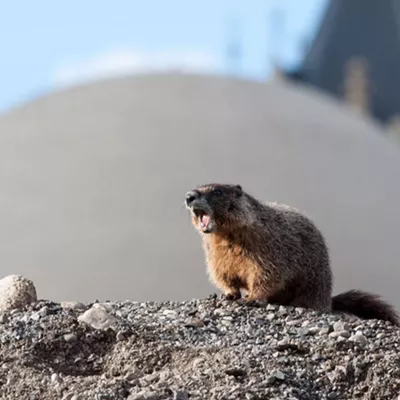Mountains piled high with snow hold the promise of relief from last year's drought -- but it's a long winter yet. Even if 2002 is wet, the parched months of the 2001 drought will be felt for a long time to come, scientists say.
Eastern Washington river basins like the Spokane are running between 110 and 120 percent of normal right now, says John Vaccaro, a hydrologist with the U.S. Geological Survey's regional Tacoma office. In the Inland area, that represents about twice the amount of last year's to-date precipitation. That's good news so far -- and not just for ski areas basking in fluffy snow packs. Still, scientists won't call an end to the drought unless snow levels remain high through the entire winter. The "make-or-break month is March," says Vaccaro.
"But at this point, we are definitely heading into a normal or better-than-normal year," says meteorologist Claudia Cox with the Spokane office of the National Weather Service.
Last year's drought was one of the worst on record in Washington. Making up for it will require not just an average precipitation year, but one that's above average. The Spokane River ran at an average of 3,000 cubic feet per second (cfs) in water year 2001 (a water year is measured from October through September), says Vaccaro. That's less than half of its historic average of 6,800 cfs.
"1.2 million cfs did not flow by Spokane last year," he says. "That's water that could have produced power or helped fish or supplied agriculture."
The 2001 drought was region-wide, stretching its dusty grip from the coasts of Washington to western Montana, lowering stream levels in Idaho's mountains, and scorching northern California. Closer to home, the Rathdrum aquifer had fallen by January to 1,880.9 feet above sea level (average measurement from seven Spokane city wells). The aquifer is an underground river flowing east to west, and it is the source of drinking water for 400,000 Inland Northwest residents. This month's aquifer measurement is a foot-and-a-half higher than last January's, according to Brad Blegen, director of the Spokane Water Department.
"That's very good news," he says, adding that 1.5 feet predicts a fuller aquifer in months to come.
Even if the snow continues to accumulate in the mountains and the spring runoff swells reservoirs around the West, the drought of 2001 will reverberate for years to come, scientists say. It wasn't just Spokane's city generators that lost power, for example, but large private power companies, too.
A residential Avista power customer pays $52.89 for 1,000 kilowatts this January, up a whopping 18 percent over last winter's price. That, according to spokeswoman Catherine Markson, is a direct result of the 2001 drought and its slackening of river flows. Power giant Avista owns six power-generating dams on the Spokane River and two on the Clark Fork in Montana.
"Our power generation was 65 percent of normal," says Markson. "That's the worst power generation on record."
Avista says the low water forced it to purchase power on the open market, which was fluctuating wildly last summer due to regional power shortages and market changes. Says Markson, "If we'd had water, we wouldn't be in the situation we are now."
That's all true, but it misses a larger point, says Andrew Ford: "The key question is whether Avista should have had enough generation capacity so they didn't have to go into the wholesale market."
Ford is an environmental science professor at Washington State University, specializing in power systems of the West. As the power industry moves from companies with an obligation to serve a specific group of people to a less-regulated market, says Ford, companies like Avista sometimes set growth and profits ahead of things like regional planning and drought preparations.
"They didn't have enough generating capacity when the dry years hit," says Ford. "They had their minds on other things."
Drought-shrunken rivers affect more than turbine generators; they play a great part in environmental health. This past year's record salmon runs up the Columbia River system were a result of an especially rainy 1997 and 1998, when full rivers carried young salmon swimming out to sea, explains John Covert, hydrogeologist with the Washington Department of Ecology at the Eastern Washington Regional Office in Spokane. The 2001 drought, he says, will likely result in a greatly diminished salmon run a couple of years from now.
River levels, or volume, affect things like the water's temperature, its acidity and its dilution of man-made pollutants. All these factors act upon salmon and other aquatic life. Then there's life on land. Drought years create conditions ripe for intense forest fires, notes Covert. "This is a quality-of-life thing. If the streams dry up or there's other [drought] problems, that can ruin our quality of life."















